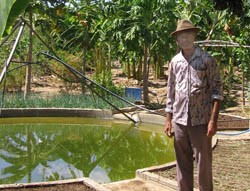
People from the semi-arid “backlands” of Brazil’s northeast are known for their persistence in eking a living out of a nearly barren land, where severe droughts force them to relocate about once each decade. Farmers produce beans and manioc, a plant with an edible starchy root, or tend the cattle of wealthier landowners for negligible pay. In a land where eating beef is the symbol of success, the farmers can almost never afford it.
Senhor José Correa, 52, is a subsistence farmer and ranch hand in the settlement of Santo Antônio de Cajazeira. Despite his pride in his region’s traditions and resilience, he was anxious to try something new so his family would be better off. That’s when Seu Zé, as he is called, turned to USAID and its partners for assistance in installing a mandala in his backyard.
A mandala is essentially a sophisticated garden that allows farmers to produce a tremendous variety of complimentary products in a small space. In the center lies a concrete pond with scarce water, where fish are raised. Around the pond lie concentric circles, where crops and livestock are raised, including vegetables, herbs, fruit, and poultry. The mandala is micro-irrigated or watered manually. The circular design reduces the amount of labor involved, and the mandala’s fixed size helps water-scarce communities ration water effectively.
Seu Zé’s backyard measures just 30 x 50 meters, but with the mandala his family has been earning $125-200 a month with sales of poultry, eggs, fruit, vegetables, herbs, and greens. The mandala also provides food security and an improved diet for his family – Seu Zé now shows off his healthy children with visible pride. Everyone in his family works in the mandala. His wife, Dona Josefa, works the land and manages the accounting. She also keeps tight control of the family’s budget, recording the sales from the local market and calculating expenses.
Not everything about Seu Zé has changed — he still prefers beef and refuses to eat “grass” (leafy greens). But the mandala has improved his family’s standard of living, and he now sees a path out of poverty and insecurity. USAID’s mandala program has been very popular, transforming the hamlet of Santo Antônio de Cajazeiras into what looks like an oasis in an arid land.







Comment
Make a general inquiry or suggest an improvement.